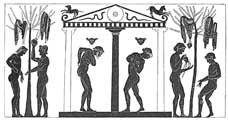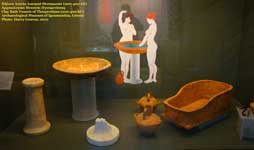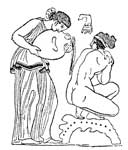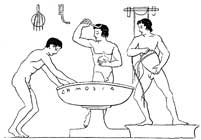.
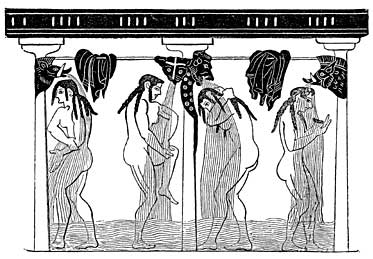
Greek Baths.—Bathing was a practice familiar to the Greeks of both sexes from the earliest times, both in fresh water and salt. Thus, Nausicaa, daughter of Alcinous, king of Phaeacia, goes out with her attendants to wash her clothes; and after the task is done she bathes herself in the river ( Od.vi. 58 Od., 65). Odysseus, who is conducted to the same spot, strips and takes a bath, while Nausicaa and her servants stand aside. Warm springs were also resorted to for the purpose of bathing. The Ἡράκλεια λουτρά shown by Hephaestus or Athena to Heracles are celebrated by the poets. Pindar speaks of the hot baths of the nymphs, and Homer ( Il.xxii. 149) celebrates one of the streams of the Scamander for its warm temperature. Bathing in rivers or the sea (ψυχρολουτεῖν) was always common for the young. Not to know how to read and to swim were proverbial marks of the ignoramus. A plunge in the Eurotas always sufficed for the Lacedaemonians (Schol. on Thuc.ii. 36). There appears to have been a swimming-bath (κολυμβήθρα) at Athens in the time of Plato ( Rep.453D).
The artificial warm bath was taken in a vessel called ἀσάμινθος by Homer, and ἔμβασις by Athenaeus. It was no doubt of wood or marble, as the epithet εὔξεστος is applied to it ( Od.iv. 48), and in the case of Menelaus's Egyptian presents ( Od.iv. 128) it was of silver. It would appear from the description of the bath administered to Odysseus in the palace of Circe, that this vessel did not contain water itself, but was only used for the bather to sit in while the warm water was poured over him, which was heated in a large caldron or tripod, under which the fire was placed, and when sufficiently warmed was taken out in other vessels and poured over the head and shoulders of the person who sat in the ἀσάμινθος. Where cleanliness merely was the object sought, cold bathing was adopted, which was considered as most bracing to the nerves; but after violent bodily exertion or fatigue warm water was made use of, in order to refresh the body and relax the over-tension of the muscles. Hesiod ( Op.754) protests against men elaborately cleaning (φαιδρύνεσθαι) their bodies with effeminate baths Op., i. e. those of high temperature, which shows that this luxury had begun in his day; and in Homer's time constant indulgence in the warm bath was considered as a mark of luxury and effeminacy ( Od.viii. 249). The use of the warm bath was preceded by bathing in cold water ( Il.x. 576). The later custom of plunging into cold water after the warm bath mentioned by Aristides (vol. i. Orat.2, Sacr. Serm. p. 515), who wrote in the second century of our era, was no doubt borrowed from the Romans.
After bathing both sexes anointed themselves with oil, in order that the skin might not be left harsh and rough, especially after warm water. The use of precious unguents (μύρα) was unknown at that early period. In the heroic ages, as well as in later times, refreshments were usually taken after the bath ( Od.vi. 97).
At Athens the frequent use of the public baths was regarded by strict moralists in the time of Socrates and Demosthenes as a mark of luxury and effeminacy; thus it is a sign of demoralization on the part of a ship's crew. Accordingly Phocion was said to have never bathed in a public bath, and Socrates to have made use of it very seldom. It was, however, only the warm baths to which objection was made, and which in ancient times were not allowed to be built within the city (Athen. i. 18 b); for the Greeks did not at all approve of people being dirty; only cleanliness, they thought, should be attained by the use of cold water.
The baths (βαλανεῖα) were either public (δημόσια, δημοσιεύοντα) or private (ἴδια, ἰδιωτικά). The former were the property of the state, but the latter were built by private individuals. Such private baths are mentioned by Plutarch ( Demetr.24). Baths of this kind were probably mostly intended for the exclusive use of the persons to whom they belonged ( Ps. Xen. Rep. Ath.ii. 10.) There appears to have been a small, almost nominal, charge for the use of the public baths. Thus, in the inscription of Andania (i. 107), the price is fixed at two chalki=1/4 obol.
We know very little of the baths of the Athenians during the republican period; for the account of Lucian in his Hippias relates to baths constructed after the Roman model. On ancient vases on which persons are represented bathing we seldom find anything corresponding to a modern bath in which persons can stand or sit; but there is always a round or oval basin (λουτήρ or λουτήριον), resting on a stand (ὑπόστατον), by the side of which those who are bathing are represented standing undressed and washing themselves.
But besides the λουτῆρες and λουτήρια there were also vessels for bathing, large enough for persons to sit in, which, as stated above, are called ἀσάμινθοι by Homer and πύελοι or μάκτραι by the later Greeks. The λουτήρ thus, as we shall see, corresponded to the Roman labrum; the πύελος to the solium or alveus.
In the baths there was also a kind of sudorific or vapour bath called πυρία or πυριατήριον, which is mentioned as early as the time of Herodotus (iv. 75). Among the chambers of the Greek bathing establishment was the ἀλειπτήριον, Lat. unctorium. Lucian ( Hipp.p. 73) speaks of the ἀποδυτήριον with its ἱματιοφυλακοῦντες (capsarii); but as they seem to be unknown to Aristotle, they were probably introduced from Rome. Hence Aristotle tells us that those who stole clothes from the baths were punishable with death. As the baths most frequently adjoined the gymnasia and palaestra, one of the rooms of these latter buildings served the purpose of undressing-room ( Ps. Xen. Rep. Ath.ii. 10). About these rooms the τριβαλλοί used to loaf, looking out for an invitation. We hear of wrestling and playing the cottabus, besides a great deal of conversation going on in the baths. To sing there was considered the part of a boor (Theophr. Char.4).
Either the bath or simple anointing of the body generally formed part of the business of dressing for dinner. It was generally taken shortly before the δεῖπνον, or principal meal of the day. Epictetus (Diss. i. 1, 29) mentions noon as the hour, while voluptuaries bathed repeatedly. It was the practice to take first a warm or vapour, and afterwards a cold bath, though in the time of Homer the cold bath appears to have been taken first and the warm afterwards. The cold water was usually poured on the back or shoulders of the bathers by the βαλανεύς or his assistants, who are called παραχύται. The vessel from which the water was poured was called ὑδρία; there is mention also of the ἁρύταινα, which must have been much smaller. Bathing establishments for women existed among the Greeks, whether belonging to the state or maintained by private enterprise. We learn from Varro (L. L. ix. 68) that the earliest Greek balneum in Rome contained a department for women.
Roulez (Choix de Vases peints du Musée de Leyde, pl. xix. 1) gives us a vase painting of a bath in a palaestra, where two shower baths descend on men from spouts shaped like panthers' heads; and Panofka (Bilder antiken Lebens, pl. xviii. 9) shows us a bath for women similarly arranged, while an unpublished vase painting in the Louvre represents a κολυμβήθρα, or swimming-bath for women.
The persons who bathed probably brought with them strigils, oil, and towels, or had them carried by a slave. The strigil, which was called by the Greeks στλεγγίς or ξύστρα, was usually made of iron, but sometimes also of other materials. Pollux says (x. 181), “The cloth which is worn by women round their loins when taking the bath, or by the men who bathe them, is called ᾤα λουτρίς.” The Greeks also used different materials for cleansing or washing themselves in the bath, to which the general name of ῥύμμα was given, and which were supplied by the βαλανεύς. This ῥύμμα usually consisted of a lye made of lime or wood-ashes (κονία), of nitrum, and of fuller's earth (γῆ κιμωλία, Ran. 710 and Schol.; Plato Rep.iv. 430A).
Among the Greeks a person was always bathed at birth, marriage, and after death; whence it is said of the Dardanians, an Illyrian people, that they bathe only thrice in their lives—at birth, marriage, and after death. The water in which the bride was bathed at Athens was taken from the fountain of Callirrhoë, which was called from the time of Pisistratus Ἐννεάκρουνος.
The natural warm springs (θερμὰ or Ἡράκλεια λουτρά) were not only esteemed as sacred to Heracles, but also considered highly medicinal. The hot springs of Aedepsus in Euboea were famed for their healing properties, as also was a cold spring
which flowed for a time (Athen. iii. 73). In later times it became a great resort for pleasure as well as health, especially in the spring.
| Ancient Greece
Science, Technology , Medicine , Warfare, , Biographies , Life , Cities/Places/Maps , Arts , Literature , Philosophy ,Olympics, Mythology , History , Images Medieval Greece / Byzantine Empire Science, Technology, Arts, , Warfare , Literature, Biographies, Icons, History Modern Greece Cities, Islands, Regions, Fauna/Flora ,Biographies , History , Warfare, Science/Technology, Literature, Music , Arts , Film/Actors , Sport , Fashion --- |

